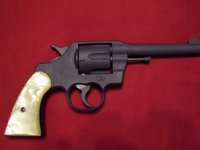Nickel removal
Duckloads, After I received my Colt I started asking around about having it refinished. Everybody wanted and arm and leg to refinish it, mainly because the nickel is hard to get off. A local guy finally told be about the Hoppes #9 trick. I bought a quart from Brownells and soaked it for a couple months in a tupperware container until it was almost evaporated. Obviously I wasn't in a hurry. After I took it out of the Hoppes, the nickel peeled off in small pieces. I did have some sandblasting to do, but it was pretty easy work. Definitely do it outside and don't use your wife's good tupperware container (ask me how I know).
I guess the process is that Hoppes is a copper solvent, and that the nickel won't adhere to the steel, so it's plated with copper first. The Hoppes gets under the worn nickel and dissolves the copper. Don't know if its right, but it worked. Afterwards, someone told be about putting it in a bucket of water with leads going to a car battery, but wasn't real clear about how not to get shocked.

